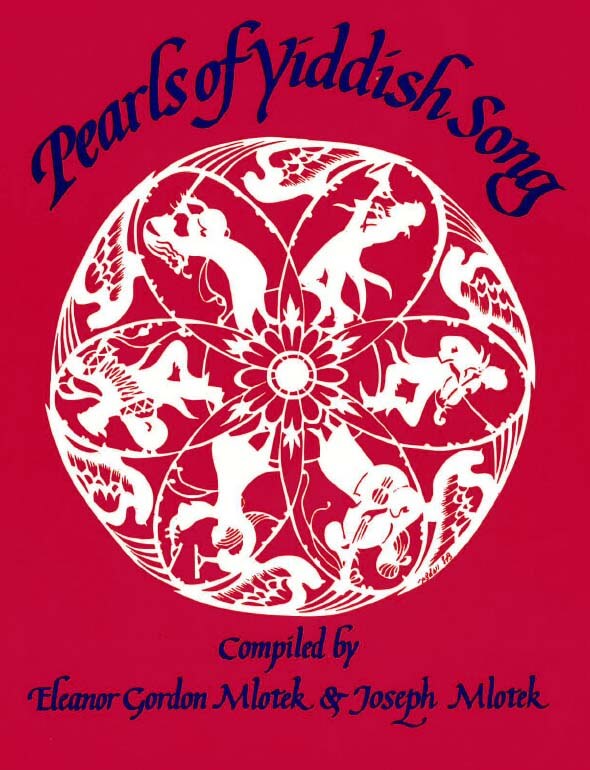A surrealistic song of a family’s poverty. Words by Berl Shafir (1876-1922); music by Peretz Hirshbein (1880-1948). Words and music published in 1918 by M. Kipnis. This is one of the cycle of 11 Yiddish songs translated into Russian that were set to music in 1948 by Dmitri Shostakovich in From Jewish Folk Poetry, Opus 79. The song appeared in a slightly varied form in Shafir’s play Avreml der shuster (Abraham the Shoemaker), published in 1910 with additional stanzas.
In the Soviet Union, the song was used to contrast the old, “moldy” world with the new Soviet youth; “Oyfn boydem hengt der dakh,/ Tsugedekt mit shindelekh./ Shteyen yatn oyf der vakh,/ Frayheyts traye kinderlekh./ Alte shtetl rut zikh oys,/ Foylinke parshoyndelekh./ Yugnt geyt in gas aroys,/ Oysglaykhn di beyndelekh./ Shimlt himl, alter skhakh,/ Altinke getseltelekh,/ Yugnt tsindn vet dem dakh,/ Brenen vein veltelekh.” (Above the attic hangs the shingled roof; young men stand guard — freedom’s devoted children. The old town rests — lazy little people. Youth goes out to stretch their limbs. Moldy sky, wilted roof, little old huts. Youth will put a torch to the roof and old worlds will burn.)
During the Holocaust, the refrain was used in several songs such as “In kazarme” (In the barrack): “Hop, hop ot azoy,/Flien di fley oyfn shtroy” (Ho, ho, this is how the fleas fly on the straw).

Above the attic, the roof is asleep,
covered with shingles;
And in the cradle lies a child
naked, without any diapers.
Hop, hop just like that.
a goat eats straw from the roof.
In the attic there stands a cradle,
a spider rocks in it;
It saps the life from me
and leaves me my poverty.
A rooster stands on the roof
and its comb is fiery red.
May my wife borrow
a piece of bread for the children somewhere.
Oyfn boydem shloft der dakh,
Tsugedekt mit shindelekh;
Un in vigl ligt a kind,
Naket, gor on vindelekh.
Refrain:
Hop, hop — ot azoy,
Est di tsig fun dakh dem shtroy.
Oyfn boydem shteyt a vig,
Vigt zikh dort a shpin in ir;
Tsit er fun mir dos khayes oys
Un dem dales lozt er mir.
Oyfn boydem shteyt a hon
Un zayn kam iz fayer-royt;
Zol mayn vayb ergets borgn
Far di kinder a shtikl broyt.
אױפֿן בױדעם שלאָפֿט דער דאַך,
צוגעדעקט מיט שינדעלעך;
און אין װיגל ליגט אַ קינד,
נאַקעט גאָר אָן װינדעלער.
רעפֿרײן:
האָפּ, האָפּ, אָט אַזױ,
עסט די ציג פֿון דאַך דעם שטרױ.
אױפֿן בױדעם שטײט אַ װיג,
װיגט זיך דאָרט אַ שפּין אין איר;
ציט ער פֿון מיר דאָס חיות אױס
און דעם דלות לאָזט ער מיר.
אױפֿן בױדעם שטײט אַ האָן
און זײַן קאַם איז פֿײַער־רױט;
זאָל מײַן װײַב ערגעץ באָרגן
פֿאַר די קינדער אַ שטיקל ברױט.
Song Title: Oyfn Boydem Shloft Der Dakh

First published in 1988 as Pearls of Yiddish Song: Favorite Folk, Art and Theatre Songs, this anthology contains 115 songs. Some material had never been published, while others, included in rare song collections or sheet music, were largely inaccessible. The songs presented reflect Jewish life in Eastern Europe and the United States and depict childhood, love, family celebrations, poverty, work and struggle. There are also songs from the Hasidic and Maskilic movements, songs of Zion and of America, as well as songs from the Yiddish theater.
The title of this anthology derives from the weekly two-page feature column “Pearls of Yiddish Poetry,” which the compilers Yosl and Chana Mlotek initiated in 1970 in the Yiddish newspaper Der Forvertz (the Yiddish Daily Forward). Hundreds of readers from around the world — including authors, composers, singers, actors — became co-participants in this collective folk project and recalled melodies, lines, fragments, stanzas and their variants of songs, poems, and plays which they had heard in their youth. At first, readers sent in only written material. Later, they also taped songs on cassettes, many of whose melodies had, until then, never been recorded. They also identified and supplied missing information regarding lyricists, poets, and composers and described the circumstances surrounding the songs’ origins, their dissemination, diffusion and impact.